The past decade has intensified a sense of siege for the rural populations in the Mekong. State-sponsored corporate firms, having staked lands once customarily and communally owned, have proven unforgiving if not downright hostile to groups and individuals asserting their right to land and resources. The latter often counsel against turning to government institutions that they fear would only instrumentalize land policies which, in the first place, seem designed to skew against the peasantry’s favor. The prospects look bleak, and it is against this entrenched injustice that grassroots and mass movements in the region push back.
Representatives of each Mekong country discussed their respective national situation, in particular on land and related human rights issues they face. These inputs deepened the participants’ grasp of local struggles and helped inform the strategy for coordination and solidarity.
Cambodia: land concessions and Chinese domination
Currently working with 56 communities in nine provinces, the Coalition of Cambodian Farmer Community (CCFC) is among those at the forefront of agrarian struggle in Cambodia, said Theng Savoeun, the president of the CCFC. He also spoke on behalf of the other Cambodian groups present at the workshop, the Cambodian Youth Network (CYN) and the Ponlok Khmer – People and Knowledge of Highlanders (PKH), both of which ally closely with various farmers’ and indigenous peoples’ groups in Cambodia.
While the richness of land in the country is conducive to crop cultivation, arable land only accounts for 61% of the total land mass, according to Savoeun, owing to vast agro-industrial concessions covering 2.3 million hectares — the majority of which services mining companies. This figure does not even include plots sequestered for railway projects and hydropower dams funded by the Asian Development Bank (ADB), the World Bank, and several major Chinese banks.
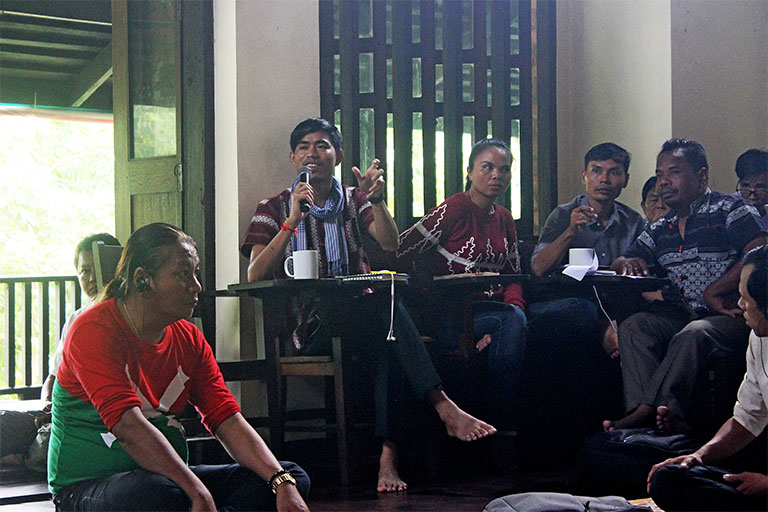
While the government can forcibly adopt lands worth a public-interest value, foreign companies can only do so principally through economic land concessions (ELCs). Concessionaires can hold long-term leases that allow for operations related to industrial-scale development, such as processing agricultural products and building factories. The government requires them to monetarily compensate the affected communities or ensure jobs for the latter and to pay property taxes. Some government officials themselves have applied for ELCs, said Savoeun, but noted that how the process of such an application goes is vague to many.
These ELCs are plentiful, because big companies, which the law says cannot apply for more than 10,000 hectares of land, opt to create sub-companies for registration. Concessions for rubber plantations cover millions of hectares, and for mixed crops just about 150,000 hectares. Policies on such investments effectively abide land grabbing, by either private entities, brokerage and state authorities, or actors involved in government-funded projects.
Of the transnational land deals in the country, over 70% are controlled by Chinese investors in light and heavy manufacturing industries, dams and airport construction, and agro-industrial food production, said Savoeun. China’s presence in Cambodia is also felt through foreign aid, which now amounts to USD70 million, mostly in the form of loans.
Savoeun attested to the growing influence of China and remarked on the efforts that groups like the CCFC spearhead to strengthen communities affected by these developments. Rural households, for example, are aided and encouraged to file class-action lawsuits against land grabbers. They also mobilize through protests, which peasant organizations reinforce with various forms of advocacy and solidarity actions.
Laos: “land into capital”
Unlike in Cambodia, there essentially exists no land classification scheme based on ownership in Laos, as the country’s 2003 Land Law explicitly confers on the state the right to control the land. Thus, while every Lao citizen can own and use land, the government ultimately has the final say where significant matters on land management are concerned, said Noudsavanh Pheungsavanh of the Land Information Working Group (LIWG), a nonprofit composed of nearly 40 different organizations working to promote awareness of the socio-economic and environmental impacts of land-related projects in Laos.
Pheungsavanh historicized patterns of land use in Laos, from when the Indochina wars between 1946 and 1989 displaced populations to when the government instituted policies to deter subsistence swidden and opium farming. Tens of thousands have since been relocated to villages near roads. Although socialist on paper, Laos started to transition towards a more pro-market bent upon gaining independence, and land has figured strikingly in pulling in foreign direct investments — hence the ‘Turning Land into Capital’ policy.
Yet the specifics of such a policy appear dim, even to investors, as it has largely never been written down. It has been interpreted and implemented in rather multifarious ways. Consequently, CSOs find it more difficult to formulate solutions as the policy’s impacts are harder to assess. Based on their understanding so far, Pheungsavanh enumerated at least four identifiable means wherein this land-business framework thrives: (1) by state land concessions and leases; (2) by land-based financing of infrastructure like railway; (3) by trading land for development; and (4) by land titling and carving out new markets for land.
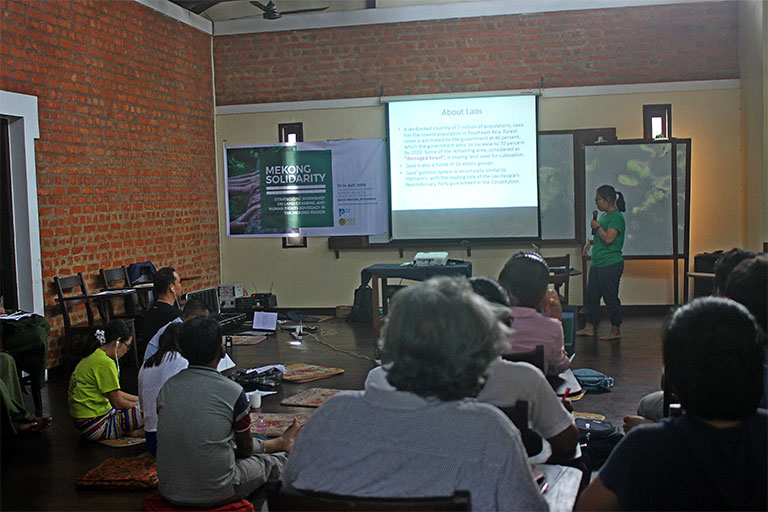
Despite the dearth of data on land conflicts in Laos, local communities make no secret of their grievances when the government requisitions their land. “The country is in a mountainous area, so rotation farming is commonly practiced,” said Pheungsavanh, “but this farming is disrupted when the government tells you that you have to sacrifice your land for a ‘larger purpose.’” The trouble, however, lies in getting such sentiments out.
Documentation of land disputes by CSOs and research-oriented groups like the LIWG becomes tricky in the face of state surveillance. Bureaucratic processes complicate the workers’ engagement with the villagers themselves. Pheungsavanh talked about integrating in one community in conflict with a Vietnamese firm, and how much of her work there could not come along, with the police shadowing her. Yet she knew the offices would otherwise deny her access to data she could have gathered from the community herself.
She said Lao peasants cry foul over issues similarly confronted by their Mekong neighbors insofar as land grabs remain indispensably linked to profit. Forests that have not been turned into monocrop plantations, or lands that have not been reallocated for animal husbandry, might become targets for a planned SEZ. Investors could secure a lease period of 50 to 99 years. Usually, as is the case, investors backed by state officials would skirt impact assessments and other project requirements to proceed to the construction of these zones. They would promise jobs to the locals and fair compensation, which almost never pans out.
Many Laotians, then, remain leery of the latest such development, the USD10-billion Khone Phapheng SEZ, dubbed what would soon be the “Hong Kong in Laos.” The Guangdong Yellow River Industry Group, a Chinese company, bankrolls this project while provincial authorities facilitate land surveys. The historical Champasak Province could very soon expect thousands of tourists swarming the hotels, restaurants, and shopping centers, among others, in this SEZ which is seen to bring more businesses into the country.
Whatever benefits can be reaped from these projects rarely go to the public coffers, said Pheungsavanh. Rarely too does news of these capital inflows reach the remote rural provinces. Only lately have people learned to utilize social media to access otherwise unheard-of information. Earlier this year, however, the Lao government hints at wanting to control social media which authorities fear could stoke dissenting views.
Myanmar: struggles for land and democracy
More than 70 land laws in place and a long history of mismanaged enforcement of agrarian policies might explain why Burmese farmers and indigenous peoples may not be as confident in their government. Myo Thant of the Farmer Affairs Network (FAN) spoke about thousands of land cases pending resolution under a legal framework that serves to justify massive land grabs in the name of vaunted development.
Chief of these problematic legislations is the recently amended Vacant, Fallow and Virgin (VFV) Land Law, introduced just last year and implemented with the majority of Myanmar’s rural population unaware of its implications. Those who had failed to register their land before what seemed a rushed deadline could be fined approximately USD328 or face up to two years in prison for supposedly trespassing on their own land.
“Those who amended the [VFV law] are people-elected parliamentarians. They used to fight authoritarian,” said Thant. “They are now oppressing the very people whom they stood up for in the past.” Many peasant groups cannot help but think the parliament railroaded the law just so foreign investments can smoothly pour in, promising greater revenue generation and a boost in Myanmar’s economy. Thant, however, admitted to harboring hopes for, at last, a robust and comprehensive land use and management program when the National League for Democracy (NLD) took power in 2015, installing Aung San Suu Kyi as the de-facto state leader.
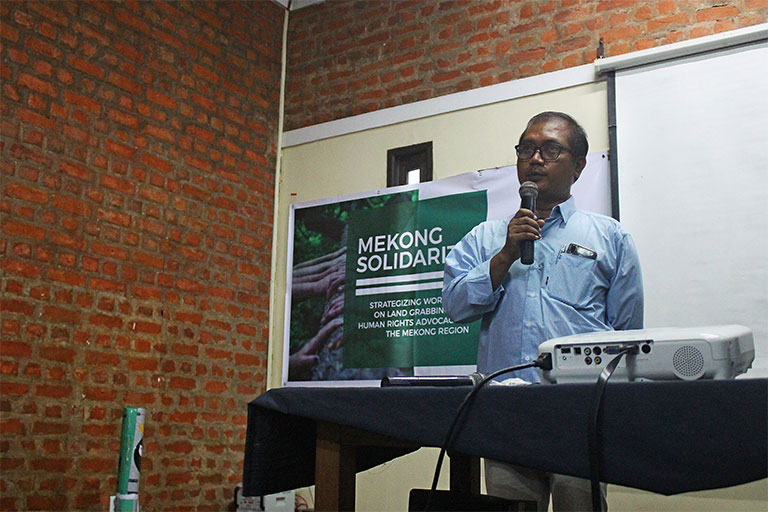
However, several Burmese participants at the workshop expressed consternation and disappointment in Suu Kyi’s incumbent administration. Several of them referred to the government’s seeming reluctance to adopt the National Land Use Policy (NLUP) crafted by its predecessor. The NLUP includes the respect and legal recognition not just of customary land rights but also of the tenure rights of women and ethnic minorities.
While neither perfect nor legally binding yet, the proposed policy is hoped to lead to more socially progressive reforms in addressing ownership claims, management issues, and corruption raps levelled against the civilian bureaucracy. These difficulties arise, in the first place, from numerous laws harking back to the draconian, colonial-era system of land governance in the country. Such has resulted in contradictory laws which the government would do well to harmonize, said Thant.
Meanwhile, the civil society continues to draw the state’s ire. The concerns of the Burmese participants at the workshop about the renewed crackdown on progressive groups were resounding. The Peaceful Assembly and Procession Law, for instance, carried over from the previous regime, remains effective at muzzling land and environmental rights activists, among others, and at criminalizing protests deemed riotous or even remotely critical of the government.
It is no wonder, then, that some CSOs and nonprofits remain politically disengaged in order to court favor from the government and, more so, from businesses and potential funders, said Thant. Still many engage only in projects for the sake of submitting good performance reports, he added while cautioning against antagonizing these kinds of CSOs. “No matter how different we are,” Thant said, “as long as we protect the interests of farmers, indigenous peoples, and workers, then we are doing a good thing.”
All efforts should instead be funneled to building genuine people’s democracy in the country. The government of Myanmar may profess claims to representative democracy, said Thant, but the conditions that the farmers, agricultural workers, and indigenous groups continue to labor under still signal threats to their rights. “The government right now is concerned with how to win the votes in the elections in 2020,” Thant added. “But if it fails to solve the land disputes, there might soon be an uprising of the rural people.”
Thailand: rural unrest
Thai CSOs and progressive groups, from pro-democracy youth to land rights activists, also contend with ongoing systematic attacks on their rights — in spite of having just held elections last March 2019 for the first time after a five-year rule of the military junta. Particularly for the agrarian sector, legal instruments meant to persecute and criminalize resistance lately bear heavily upon farmers and community leaders.
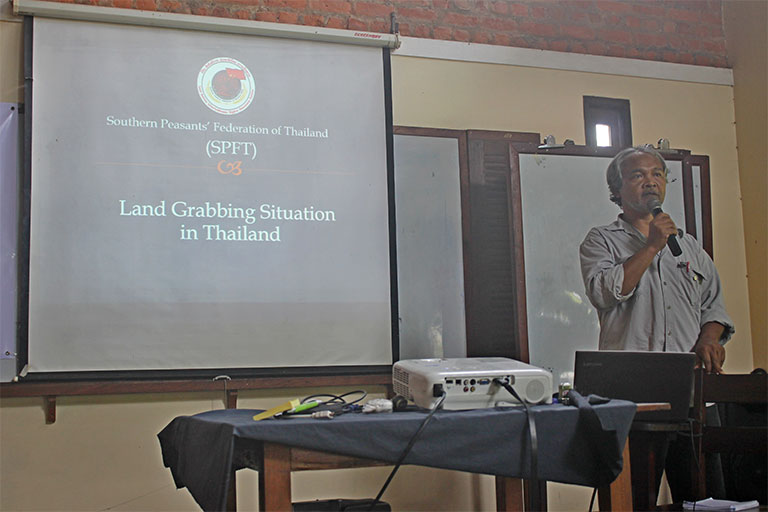
Songruk Suraphon, advisor and coordinator of the Southern Peasants’ Federation of Thailand (SPFT), said that rural unrest persists, for a small political elite maintains a monopoly on much of the land. Businesses also share control over the southern portion of the country, with palm oil companies insisting on staying on despite their leases having long expired. In response, peasant groups initiate land occupation activities on uncultivated plots, both to mount pressure on companies and to exercise their right to land.
The SPFT helps local people in this regard by resonating the latter’s campaign for genuine agrarian reform that ensures equitable redistribution of land. Apart from policy advocacy, the group has led communities to establish camps and settlements on disputed lands from which they were driven out. For example, the original settlers on a recently declared private land in Nam Daeng Phattana community in Surat Thani province have been awaiting, for years, the resolution to their appeal before the Supreme Court. The private claimants, in retaliation, filed trespassing charges against seven of the villagers who later had to post bail.
Similar instances of mass eviction are even more prevalent where plantations are involved. The Bo Kaew community in Chaiyaphum province, for instance, faces displacement this year after losing a lawsuit to a eucalyptus plantation company at the Supreme Court. Twenty-one residents were also sued by the Forest Industry Organization (FIO), a state enterprise entrusted with practically unchecked discretion to award certificates to private firms for government ventures into and industrial use of Thai forests.
Despite low business confidence level in the country, its reserve and protected areas are still shrinking to give space for corporate developers in the rubber, sugar, and mining industries, among others. Suraphon pointed out that the aggression of corporate bodies motivates peasant groups to consolidate stronger campaigns on the ground. In Surat Thani province, villagers in the Klong Sai community, with the help of the SPFT, opted to reclaim a parcel of land leased to a big palm oil company and pursued an almost decade-long struggle.
“To mobilize them,” said Suraphon, “we keep raising their awareness of social issues and empowering one another.” He admitted to mishaps along the way, in particular the death of four of their members, but he said the community could only carry on their struggle and ensure what they lived up to will not go in vain. “After all,” he added, “they can kill a fighter, but they cannot kill the fight.”
Vietnam: compensation and conflicts
Opposition to land grabs may court repressive actions to a lesser degree than in a country like Thailand. Yet what remains a common denominator in the Mekong is the exertion of state and corporate powers to divest rural populations of land and resources. In central Vietnam, for example, land use plans pursuant to the revised Land Law in 2013 allow for enterprises to acquire plots in exchange for some compensation to locals based on market price. Such acquisitions are often for either residential or agricultural purposes.
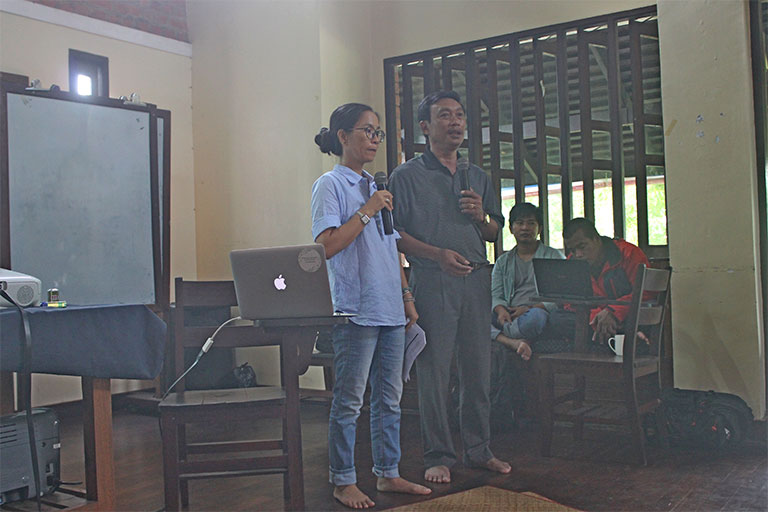
The question of compensation incites many land conflicts in Vietnam, said Tran Thi Thanh Toan, program manager at the Center for Sustainable Rural Development (SRD). She cited a 2018 survey by the Public Administration Performance Index (PAPI) that indicates almost half of those who lost agricultural land expressed dissatisfaction with the compensation they received.
There have been cases where the land area actually taken over did stretch further than what villagers had been compensated for. Notwithstanding meetings and consultations between investors and communities, the extent of the new development surprises the latter most of the time and belies even several details in the environmental and social impact assessments required to have been conducted prior to the construction.
Tran recounted a road construction project that precisely demonstrated the same scenario and how the community fought to demand a more just compensation. Some evicted residents, in protest, opt to live by the side of the road, even to their own detriment. For one, land erosion remains a serious threat along with waterlogging and drainage blockages. This is as much social as it is ecological, given the project of rural urbanization gaining steam in Vietnam, at the expense of rural peoples and their immediate environment.
To diffuse these tensions and democratize decision-making processes related to land, CSOs like the SRD advocate a framework called participatory land use management. At its heart is the aim to lend primacy to the concept of free prior and informed consent. While it recognizes the state’s autonomy in governing over all lands in Vietnam, it also seeks to yield spaces for heeding individual and collective complaints, and, should the need arise, even some intervention by the local authorities in acting upon the concerns of the community. Besides, the government must empower its people and advance their welfare, said Tran.

#NoLandNoLife Features discuss recent developments, events, and trends on land and resource grabbing and related human rights issues in the region as well as the factors and forces that drive it. Send us your feedback at nolandnolife@panap.net.








Discussion about this post